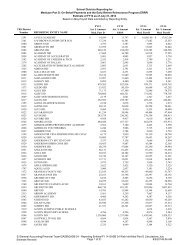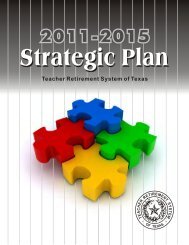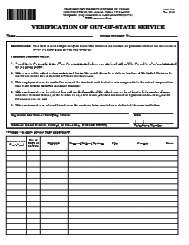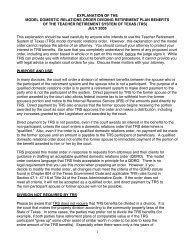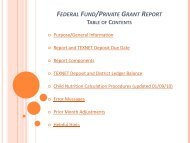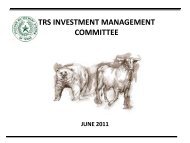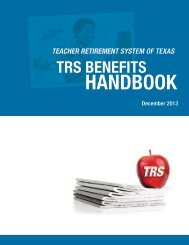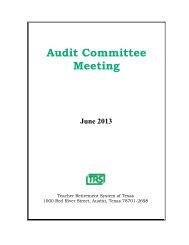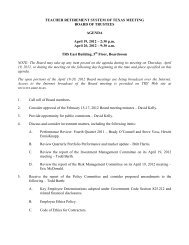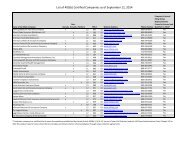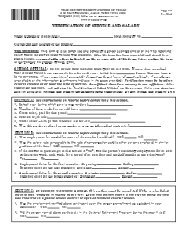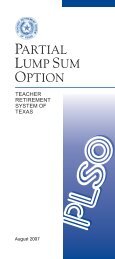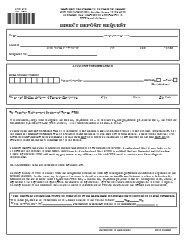TRS 2011 Comprehensive Annual Financial Report
TRS 2011 Comprehensive Annual Financial Report
TRS 2011 Comprehensive Annual Financial Report
You also want an ePaper? Increase the reach of your titles
YUMPU automatically turns print PDFs into web optimized ePapers that Google loves.
TEACHER RETIREMENT SYSTEM OF TEXAS COMPREHENSIVE ANNUAL FINANCIAL REPORT <strong>2011</strong><br />
Notes to the <strong>Financial</strong> Statements<br />
tal Accounting Standards Board (GASB). Governments also have the option of following subsequent private-sector guidance for their<br />
enterprise funds, subject to the same limitation. <strong>TRS</strong> has elected not to follow subsequent private-sector guidance.<br />
C. NEW ACCOUNTING PRONOUNCEMENTS<br />
GASB Statement No. 59, <strong>Financial</strong> Instruments Omnibus was issued in June 2010, and is effective for periods beginning after June<br />
15, 2010. The objective of this Statement is to update and improve existing standards regarding financial reporting and disclosure<br />
requirements of certain financial instruments and external investment pools for which significant issues have been identified in practice.<br />
The requirements of this statement were implemented by <strong>TRS</strong> during fiscal year <strong>2011</strong>.<br />
D. COMPARATIVE DATA IN TOTAL<br />
The basic financial statements include certain prior-year summarized comparative data in total but not at the level of detail required<br />
for a presentation in conformity with generally accepted accounting principles. Accordingly, such information should be read in conjunction<br />
with the system’s financial statements for the fiscal year ended August 31, 2010, from which the summarized information was<br />
derived. Certain items from the prior year’s financial statements have been reclassified to conform to the presentation in the current<br />
year’s financial statements. These reclassifications had no effect on previously reported net assets.<br />
E. BUDGETS AND APPROPRIATIONS<br />
The administrative costs and capital outlay for each of the system’s funds and programs are controlled by annual budgets approved<br />
by the board of trustees.<br />
The Pension Trust Fund receives state contributions for retirement benefits from general revenue appropriations. In fiscal years<br />
<strong>2011</strong> and 2010, contributions were made to the retirement system at the rate of 6.644% of the aggregate compensation paid to active<br />
retirement system members for each year. Although appropriated by the legislature, administrative expenses and capital outlay for the<br />
Pension Trust Fund are paid from the fund’s Expense Account, and not from the state’s General Fund. However, for each fiscal year of<br />
the 2010-<strong>2011</strong> biennium, the 81st Legislature, Regular Session appropriated $3.7 million of general revenue to fund exempt salary positions.<br />
In response to the letter from the Governor, Lieutenant Governor and Speaker of the House dated January 15, 2010, requesting a<br />
reduction in General Revenue and General Revenue-Dedicated spending by five percent, <strong>TRS</strong> returned all of the appropriations as a part<br />
of this statewide cost saving effort.<br />
<strong>TRS</strong>-Care (Retired Plan) receives appropriations from the state’s General Fund equal to 1.0% of the salaries of public education<br />
employees. Administrative expenses for this program are paid from the trust fund.<br />
The two Enterprise Funds, <strong>TRS</strong>-ActiveCare and the 403(b) Certification Program, are supported by fees and receive no appropriations<br />
from the state for administrative expenses.<br />
Effective September 1, 1997, legislation authorized <strong>TRS</strong> to administer a governmental excess benefit arrangement under section<br />
415(m) of the Internal Revenue Code of 1986 (26 U.S.C. section 415(m)). This legislation created a separate, non-qualified, unfunded<br />
excess benefit arrangement outside the trust fund of the retirement system. Contributions to this arrangement are made from the state’s<br />
general revenue appropriations. These contributions are not held in trust and may not be commingled with other funds of the retirement<br />
system. They yield no net assets; therefore, for reporting purposes only the contributions and benefits are reflected on Exhibit II, Statement<br />
of Changes in Fiduciary Net Assets.<br />
F. ASSETS, LIABILITIES AND LEGAL RESERVES<br />
Investments<br />
Short-term investments are those maturing within one year of purchase date. Included in short-term investments are foreign currency<br />
contracts. At the time the system is notified that an international trade has been consummated, the system trader will buy or<br />
sell a foreign currency exchange contract in the currency native to the security transaction for settlement date. These foreign exchange<br />
contracts are reported at the spot rate and the net difference between the value of the foreign currency and the U.S. dollar is reported<br />
in the net appreciation (depreciation) in fair value of investments. Risks associated with such contracts include movement in the value<br />
of the foreign currency related to the U.S. dollar and the ability of the counterparty to perform. Transactions involving foreign currency<br />
are accounted for in accordance with FASB Accounting Standards Codification (ASC) 946-830; the subtopic “Foreign Currency Matters”<br />
of the topic “<strong>Financial</strong> Services – Investment Companies”.<br />
Investments are reported at fair value. The framework for measuring fair value is based on a hierarchy that gives the highest priority<br />
to the use of observable inputs in an active market and the lowest priority to the use of unobservable inputs. Management’s estimated<br />
market values for investments without readily ascertainable market values could differ significantly if a ready market for these assets<br />
existed. Because of the inherent uncertainties in estimating fair value, it is at least reasonably possible that the estimates will change<br />
in the near-term.<br />
Global foreign exchange holdings are translated using the London 4 O’clock Closing Spot Rate from a third party vendor.<br />
The fair value of equity investments is measured based on the primary exchange last sale price or the official close price from the<br />
FINANCIAL SECTION<br />
41



